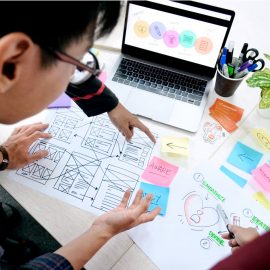
What if creating lasting change didn’t require endless energy, big budgets, or radical overhauls? In Reset, Dan Heath shows that progress often comes from small but strategic shifts. Whether you’re trying to improve your personal habits or lead your organization through a tough transition, Reset argues that you don’t need to do everything—you just need to do the right things in the right places.
Drawing on research and case studies, Reset distills practical strategies for making meaningful improvements without burning out. Continue reading for an overview of the book.
Overview of Reset by Dan Heath
In Reset, Dan Heath argues that big changes don’t require superhuman effort or vast resources. All it takes to get your organization (or yourself) out of a rut is to take a step back, rethink your approach, and refocus your efforts where they’ll make the biggest difference.
Heath is a best-selling author and organizational change expert who has spent over two decades studying how individuals and organizations can successfully navigate transitions and implement lasting change. Along with his brother Chip Heath, he co-authored several influential business books, including Made to Stick, Switch, and The Power of Moments, which have collectively sold millions of copies. Heath’s expertise stems from his extensive research background and his work as a consultant with major corporations.
Our overview of Reset will begin by exploring different ways to find key areas where you can make the greatest improvements with the least effort. We’ll then discuss why it’s important to start any major change with a big push toward your new goals, and how you can do so effectively. To conclude, we’ll explain how you can drive organizational change more easily by harnessing your workers’ energy and motivation, as opposed to forcing those changes through on your own.
Find Opportunities for Change
Heath begins by saying that big changes come from making relatively small efforts in specific, strategic areas. Much like untangling a knot starts with finding the right string to pull, fixing organizational (and personal) problems starts with finding the right places to apply your efforts.
In this section, we’ll discuss three ways you can search for those key areas:
- Finding your limiting factor—the weak point that restricts your ability to make changes and improvements
- Finding ways to build upon what’s already going well
- Determining what your objectives really are, and which short-term goals will get you closer to those objectives
Strategy #1: Look for Your “Limiting Factor”
Heath’s first strategy is to find your limiting factor: the one thing that’s most constraining your ability to achieve your goals. The constraint might be physical (like a company’s lack of equipment, or your personal health), logistical (like how much time you have available, or the processes you need to slog through at work), or human (like a skills gap). Crucially, it also affects how well many other things work. Therefore, until you address your limiting factor, improvements in other areas won’t translate into better overall performance.
For example, it doesn’t matter how much you improve your job skills if you’re too sick to work—you’ll need to address your health in order to meaningfully boost your productivity. Similarly, there’s only so much you can do for a company that’s being held back by some limiting factor like chronic understaffing.
Once you’ve identified your limiting factor, you can focus your efforts on relieving that bottleneck. This targeted approach is far more effective than trying to improve everything at once, and it also avoids the issue of wasting resources on “improvements” that don’t address the actual problem.
Heath also notes that your limiting factor is likely to change over time. Sooner or later, you’ll find you’ve bolstered one factor so much that something else has now become your weakest point. At that point, continuing to work on what used to be your limiting factor will not lead to better results.
Continuing the previous examples, you might improve your health until you find that your biggest problem is now a lack of time; you can work steadily throughout the day, but simply can’t accomplish everything you want to in the time you have. In that case, your efforts should now go toward finding ways to free up more time for yourself, such as by getting rid of commitments that don’t serve your goals. For the organizational example, you might fix your staffing problems and find your new bottleneck is that you don’t have enough equipment for all of them to use.
Tip: Find Limiting Factors Through Firsthand Study
If you’re trying to create organizational change (as opposed to personal change), Heath says that one of the most effective ways to find a limiting factor is to immerse yourself in day-to-day operations. This direct observation will let you get firsthand knowledge of how things are done and why. However, it’s important that you don’t get in your workers’ way or interfere with normal operations, so the author urges you to just stand back and watch.
This strategy is particularly useful for solving workflow issues because without it, your management decisions will probably be based in part on flawed assumptions and secondhand information. Direct observation shows you how things actually work, as opposed to how you think they work.
Heath also advises having frank conversations with your workers to gain further insights. You’ll likely find that your frontline workers already know exactly what the limiting factor is—after all, they deal with it as a regular part of their jobs—but company leadership has never asked them for their thoughts.
Strategy #2: Find What’s Already Working
Whether you’re struggling with professional or personal difficulties, there will also be times when things work out particularly well for you. You’re liable to overlook these high points because you’re focused on what’s not working, but Heath says your successes contain valuable lessons about what’s possible with your current resources and constraints.
The author urges you to study your best performances and look for patterns: conditions, behaviors, or mindsets that consistently lead to better outcomes. For example, in an organizational setting, maybe you find that your employees get more done when they’re listening to music, or when the temperature is a little higher or lower than usual. On a personal level, perhaps you find that going to the gym early in the morning works better for you than trying to go after work, or vice versa.
Learning from existing successes is also valuable because it overcomes many of the most common psychological barriers to change. For instance, you can’t argue that something is impossible if you or someone on your team is already doing it, and you don’t have to debate whether a particular approach will create the desired outcomes when it’s already doing so.
Strategy #3: Figure Out What You Actually Want
Finally, Heath argues that the biggest barrier to progress is sometimes just confusion about what you’re trying to achieve. In other words, you might be pursuing goals that sound reasonable but don’t actually serve your ultimate purpose. If that’s the case, you could achieve all of your goals and find you haven’t actually accomplished anything meaningful.
Avoiding this trap requires you to regularly examine not just your goals but also the reasons behind those goals. This deeper examination often reveals that there are multiple paths to your real objective, some of which might be far easier than your current approach. For example, if your goal is to earn a certain amount of money, consider what you plan to use that money for. Do you actually need that amount of money to achieve your end goal, or are there other ways to get what you want?
Start Strong With Focused Efforts
Another reason Heath gives for why people often fail to make changes is that improvements are too slow and distributed too widely—as a result, their progress gets lost among all the business of day-to-day life. This lack of visible progress saps people’s motivation and allows old habits to reassert themselves. So, to avoid this problem, the author suggests starting any attempt at major change with a brief but intense period of focused effort. You can accomplish this by temporarily putting aside some of your regular activities, thereby freeing up more time and energy for the changes you plan to make.
In this section, we’ll discuss Heath’s two-step process for finding the time and energy you need to start major changes:
- Get rid of activities that aren’t improving your life
- Rebalance your remaining activities to prioritize only the most important ones, and devote less of your schedule to the others (without removing them completely).
Step #1: Eliminate Wasteful Activities
Heath says the easiest resources to overlook are the time and energy you spend on activities that don’t get you closer to your goals. Therefore, the easiest way to make rapid, visible progress is to remove those unproductive activities from your life and redirect your efforts toward whatever change you want to make.
Every organization is bound to have some wasteful activities: for instance, time-consuming workarounds for problems that no longer exist, policies and procedures that add complexity without significantly improving product quality, or unneeded oversight that bogs down workers and supervisors alike. To find opportunities to streamline your operations, Heath suggests looking at your work through your customers’ eyes. What do they actually want or expect from your company, and which activities really contribute to those outcomes? Conversely, what tasks don’t have much impact on your end product?
For example, suppose your company makes cars. It’s only natural that quality control would be one of your top priorities, so those activities should remain untouched—your customers will expect functional and safe cars. On the other hand, if you’re pulling workers into meetings over inconsequential mistakes, that’s most likely wasting everyone’s time and energy (including yours). Customers don’t expect or want your employees to be punished for human error; they just want the cars to get built.
On a personal level, Heath says wasteful activities could be anything—for example, putting in extra time at an unfulfilling job, wasting hours scrolling through social media, or continuing a hobby you no longer enjoy out of habit. In short, anything that takes up your time, energy, or other resources without substantially improving your life is a good candidate for removal.
Step #2: Rebalance Your Schedule
If you’ve eliminated obvious waste but still need more resources to create the changes you want, Heath warns that you’ll face some harder decisions. That’s because finding those resources is now a matter of rebalancing the time and effort you’re putting toward each of your remaining activities, rather than cutting activities out entirely.
As always, the key is to be strategic. Heath cites the Pareto principle (also known as the 80/20 rule), which is a common rule of thumb stating that 80% of what you achieve comes from just 20% of what you do. Therefore, identifying those few key activities will allow you to divert time and resources from less important areas, leading to greatly improved results.
For example, Microsoft discovered that approximately 80% of its software problems were caused by just 20% of its identified bugs. So, rather than trying to fix every single bug before release, they first focus on identifying and fixing that critical 20%. This means that, say, a memory leak affecting thousands of users would probably get immediate attention, while a minor display glitch that only affects a handful of users would be deferred to a later update.
Harness Other People’s Energy for Change
So far, we’ve discussed how to identify areas of opportunity where you can make major changes with relatively little effort, and how to start strong by eliminating waste and focusing your efforts for a big initial push. In this final section, we’ll explore how you can harness people’s intrinsic motivations as a powerful source of energy for organizational changes. We’ll start by discussing the importance of understanding what your workers’ motivations are. We’ll then conclude by explaining why it’s often more effective to empower others to create change and solve problems, rather than trying to handle everything personally.
Understand What Your Workers Want
Heath begins by saying that one of the most powerful yet underutilized resources is people’s intrinsic motivation (their drive to do work for its inherent satisfaction rather than an external reward). This means you can identify where your workers’ existing interests align with the changes you want to make, rather than trying to convince them to care about your priorities. By doing so, you’ll create sustainable energy for change—people will motivate themselves, rather than needing your constant attention to keep a project moving.
To tap into your workers’ intrinsic motivation, you must help them see connections between their interests and organizational needs. Therefore, the first step is to make sure you understand what your people care about. For instance, what values are most important to them? Which aspects of their work do they find engaging, and what problems frequently frustrate them? Once you understand your workers, you can start thinking about how to leverage their individual skills and personalities.
Empower Your Workers
Heath’s final piece of advice is to give your people personal ownership over identifying problems and developing solutions. He argues that this is both more effective and more efficient than trying to lead every change initiative yourself.
He says that the people who do the hands-on work (as opposed to supervisors, managers, or executives) often have the best ideas for improving an organization and its processes. Employees just need leadership’s permission, guidance, and support to implement their ideas. Therefore, Heath urges you to clearly communicate what needs to be done, but let your workers figure out how to do it. They’re likely to come up with possibilities and opportunities that you would never have found on your own.






